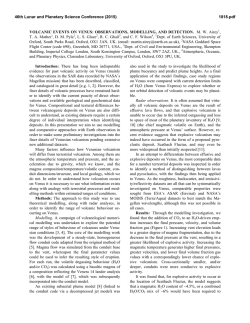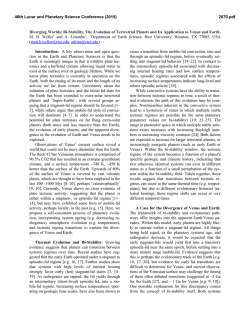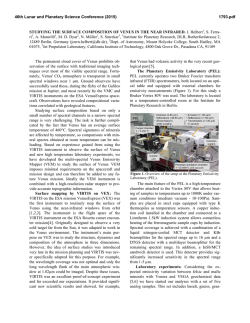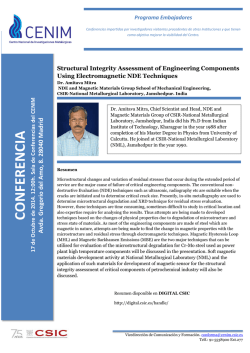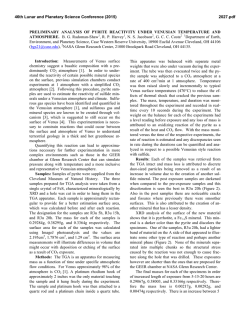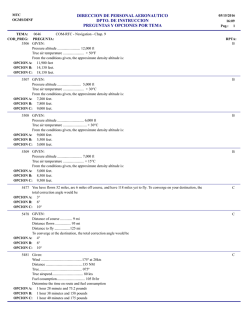
An Overview of Lightning Induced Whistler
46th Lunar and Planetary Science Conference (2015) 2341.pdf AN OVERVIEW OF LIGHTNING INDUCED WHISTLER-MODE WAVES OBSERVED BY VENUS EXPRESS. R. A. Hart1, C. T. Russell1, T. L. Zhang2 ,1Department of Earth, Planetary, and Space Sciences, University of California, Los Angeles, USA ([email protected]), 2Space Research Institute, Austrian Academy of Sciences, Graz, Austria. Introduction: Venus is a strange world when compared with Earth. It has a dense CO2 atmosphere, low water content, and lacks plate tectonics and an intrinsic magnetic field. The surface of Venus has a temperature of 700 K and a pressure of 90 bar. Cloud layers composed mainly of sulfuric acid exist at an altitude of about 45 to 65 km in contrast to Earth’s water-rich clouds, which form in the troposphere at 1 to 10 km. Despite the many differences, it is sometimes referred to as “Earth’s twin” due to its similar size, mass, and interior structure. Venus also exhibits familiar terrestrial processes including volcanism and lightning. Due to the high altitude of the Venus cloud layers and the extreme surface pressure, it is not likely that there would be any cloud to ground lightning as this would require an unrealistic amount of charge build up. However, the conditions within the cloud layers of Venus are not unlike those on Earth. The sulfuric acid in the clouds can carry charge similarly to the water in Earth’s clouds and they exist at altitudes where the pressure is similar to that of Earth’s. Therefore, the cloud layer is where the majority of lightning is expected to occur on Venus. Lightning produces an extremely low frequency (ELF) radio wave that can propagate along magnetic field lines to reach a spacecraft, such as Venus Express, at much higher altitudes. Venus Express has now completed its more than 8.5 year tenure in orbit around Venus. Throughout the mission it was in a 24 hour elliptical polar orbit with periapsis at ~80° latitude at orbital insertion in 2006. It then precessed near the pole in 2009 and ultimately finished its mission with periapsis at ~72° latitude (Figure 1). For the first few years the altitude of periapsis reached ~250 km above the surface, but later it commonly descended to ~165 km. In mid-2014 the spacecraft performed an aerobraking maneuver in which it descended further into the atmosphere down to ~130 km at its lowest point. Measurements: The onboard dual fluxgate magnetometer was able to detect ELF signals up to 64 Hz at various altitudes thoughout the mission [1]. We analyzed 10 minutes of data about periapsis for each available orbit. An average of ~700 seconds of ELF wave activity was observed for each Venus year (225 days). The average signal length is 6 seconds with some spanning nearly 1 minute. The longer signals are most likely multiple overlapping bursts when the spacecraft was above an electrical storm. These signals, also re- ferred to as whistler-mode waves, were most frequently seen when the spacecraft was at ~250 km altitude. Figure 2 shows the number of seconds per thousand of ELF signals detected at various altitudes. More than 70% were observed within 200-350 km altitude with a rate of ~1% of the time the spacecraft spent at these altitudes. The maximum detection rate at this altitude is expected due to the slower wave speed here that results in a larger magnetic amplitude for the same electromagnetic energy flux. Figure 1. The periapsis of Venus Express has been decreasing in latitude ~3° per year since 2009. Figure 2. Per mil of time of ELF wave activity observed by Venus Express at various altitudes calculated over all local times and latitudes. Signal Analysis: The Venus Express magnetometer can observe lightning-generated signals up to 64 Hz. Whistler-mode (ELF and VLF in the Earth’s ionosphere, but only ELF at Venus) are guided well up to about ¼ of the local electron gyrofrequency. Venus Express should be able to study atmospheric lightning emissions as long as the background magnetic field in 46th Lunar and Planetary Science Conference (2015) the ionosphere is greater than 10 nT thus providing a magnetic pathway through the lower ionosphere. This happens frequently, and Figure 4 illustrates some recent examples of the waves seen. We show first the power in the waves as a function of frequency. (The white line shows the magnetic field strength.) Note the increase in power at 01:49:47. Next is the ellipticity of the waves. Whistler-mode waves should be righthanded, giving a red color to the dynamic spectrum. The third panel is the direction of the wave propagation relative to the magnetic field. Dark blue indicates the waves are propagating parallel to the magnetic field. The time series is given in Figure 3 indicating that the field is aligned with the north component. The radial and east components shift in the middle of this observation allowing the wave to propagate to the spacecraft more efficiently, which is illustrated by the corresponding power increase in Figure 4. This event is just one example of ~100 per Venus year, each confirmed as a whistler-mode wave by the same analysis. Discussion: Venus Express marks the end of the current era of exploration at Venus and currently there are no future approved missions besides the Japanese Akatsuki mission which will attempt a second try at orbital insertion in late 2015. Although Venus Express provided a wealth of data to advance the study of lightning on Venus there is still much to learn, such as temporal and spatial mapping of the actual storms from which these signals are detected. The majority of the lightning generated whistler-mode waves in the Venus ionosphere were observed at ~250 km altitude. As well as being the most effective location for a spacecraft to detect these ELF waves on Venus, this altitude is ideal for radar mapping. A joint radar-lightning mapping mission could be a prime candidate for the next mission to our sister planet. 2341.pdf Figure 4. Dynamic spectra of transverse power, ellipticity, and propagation angle for event in mid-2012. The white line is the total magnetic field strength in nT. References: [1] Russell, C.T. et al. (2006) Planet. & Space Sci., 54, 1344–1351. Figure 3. Time series of magnetic field along radial, east, and north directions for event in mid-2012. The spacecraft altitude, latitude, and local time are given above the plot.
© Copyright 2025
